- Home
- Encyclopedia
- The Overland Trail In Wyoming
The Overland Trail in Wyoming
In the wake of the California gold rush, traffic by Euro-Americans along the Oregon/California/Mormon Trail across what’s now central Wyoming grew dramatically for three years, and then, in the 1850s, stayed high. This was the old fur-trade route up the North Platte and Sweetwater rivers to South Pass, after which the routes divided according to a traveler’s destination—California, Oregon or Utah.
The increased traffic brought increasing resistance from tribal people whose lives and lands the trail cut through, heavily damaging their economies and cultures. Gold strikes on the Front Range in what’s now Colorado in the late 1850s brought a new flood of white people and more conflict. To deal with these conflicts, meet demands for new transcontinental routes into and out of Colorado and to bolster its campaign to reassert federal power in Utah, the U. S. Army developed a shorter route west. It ran across what’s now southern Wyoming, and it came to be called the Overland Trail.
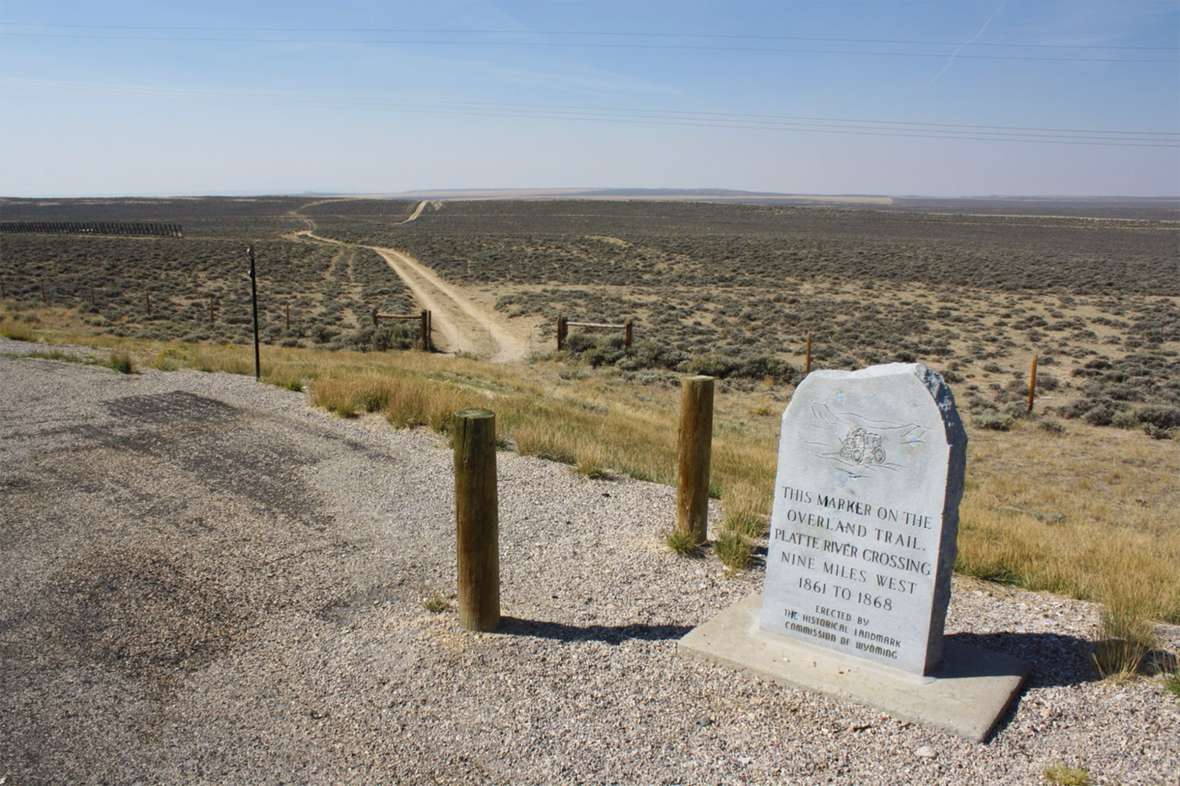
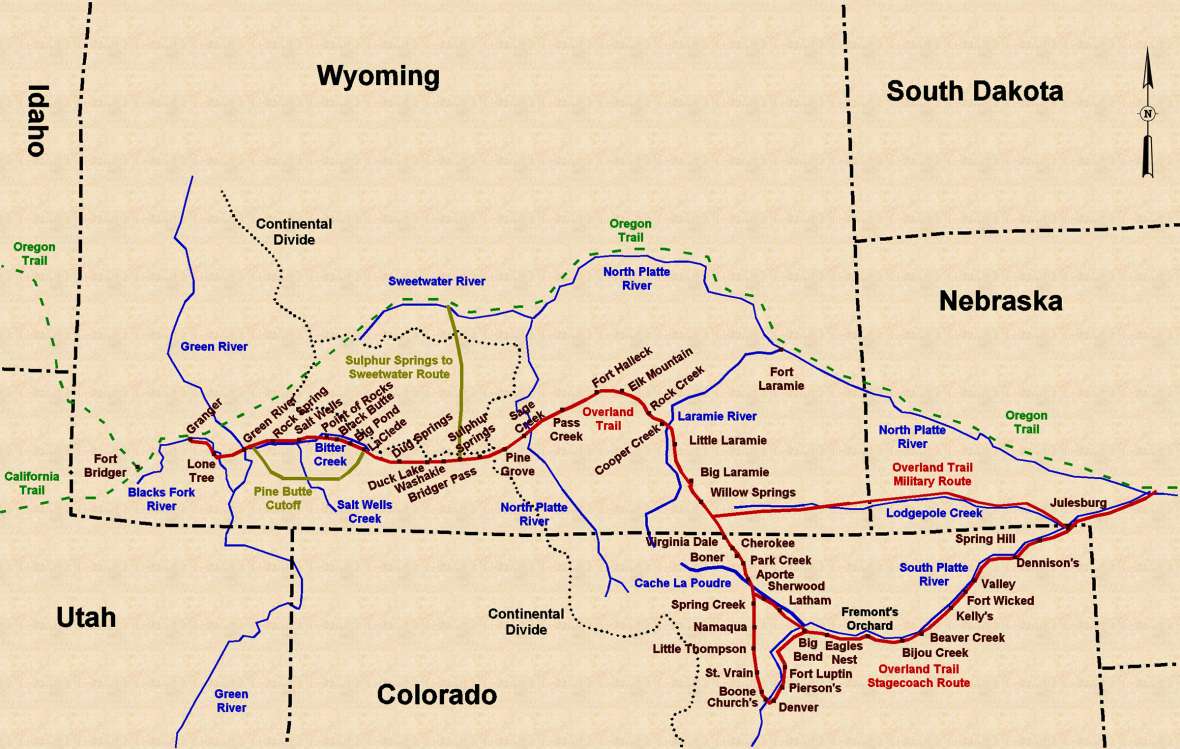
Location
The Overland Trail began along the Platte River in today’s western Nebraska where it diverged from the Oregon Trail. The Oregon Trail followed the North Platte River to Fort Laramie, the Sweetwater River and South Pass, all in present Wyoming.
The east end of the Overland Trail followed two distinct routes. One followed the South Platte River to today’s Denver and then turned north along the Front Range to the Cache la Poudre River and Virginia Dale before entering present Wyoming south of what’s now Laramie. This became the stagecoach and Overland Mail route. Much of the trail running north from Denver through present southeastern Wyoming followed the earlier Cherokee Trail.
The second Overland Trail route followed Lodgepole Creek. (See map.) This segment began at Julesburg, Colo., and continued through present western Nebraska along the route later followed by the Union Pacific Railroad, the Lincoln Highway, and U.S. 30. This was the original military road. Emigrants used both routes.
The two routes met near what’s now Laramie and the Overland Trail continued west, crossing the Laramie and Medicine Bow rivers and passing the north side of Elk Mountain along Rattlesnake Creek. The trail crossed the North Platte River 14 miles south of present Interstate 80 and then crossed the Continental Divide at Bridger Pass south of present Rawlins, Wyo. West of the Divide, the Overland Trail followed Muddy Creek and then skirted the south edge of the Red Desert before reaching Bitter Creek. The trail ran along Bitter Creek to the Green River and then followed the Blacks Fork River to rejoin the Oregon Trail at present Granger, Wyo.
The Military Surveys: 1850-1858
Capt. Howard Stansbury of the U.S. Army Corps of Topographical Engineers pioneered the route of the Overland Trail in present Wyoming. Stansbury was returning east after completing a topographical survey of the Great Salt Lake. Upon reaching Fort Bridger in September 1850, Stansbury hired Jim Bridger as a guide to locate a direct route east avoiding South Pass. Bridger guided Stansbury’s party along Bitter Creek, Muddy Creek, through Bridger Pass and past the north side of Elk Mountain before turning north to Fort Laramie.
In 1856, the Army became interested in developing Stansbury’s route as a military road. In the summer of that year, Lt. Francis Bryan was ordered to survey a route for a military road from Fort Riley, Kan. to Bridger Pass. Bryan followed the Platte River west to the mouth of Lodgepole Creek at present Julesburg, Colo. Bryan then followed Lodgepole Creek across southwestern Nebraska Territory and southeastern Wyoming, then part of Dakota Territory. He followed Stansbury’s route around Elk Mountain, and on to Bridger Pass. On his return trip, Bryan turned southeast on the Cherokee Trail toward the Cache la Poudre, Crow Creek, and the South Platte River, in future Colorado.
Bryan’s assessments of the Lodgepole Creek-Bridger Pass and the South Platte River routes were positive although the lack of water, grass and wood in certain areas was seen as problematic. In 1857 and 1858, Bryan returned to the Lodgepole Creek-Bridger Pass route with a second expedition. Bryan’s troops improved the trail, including building bridges across several large rivers and creeks.
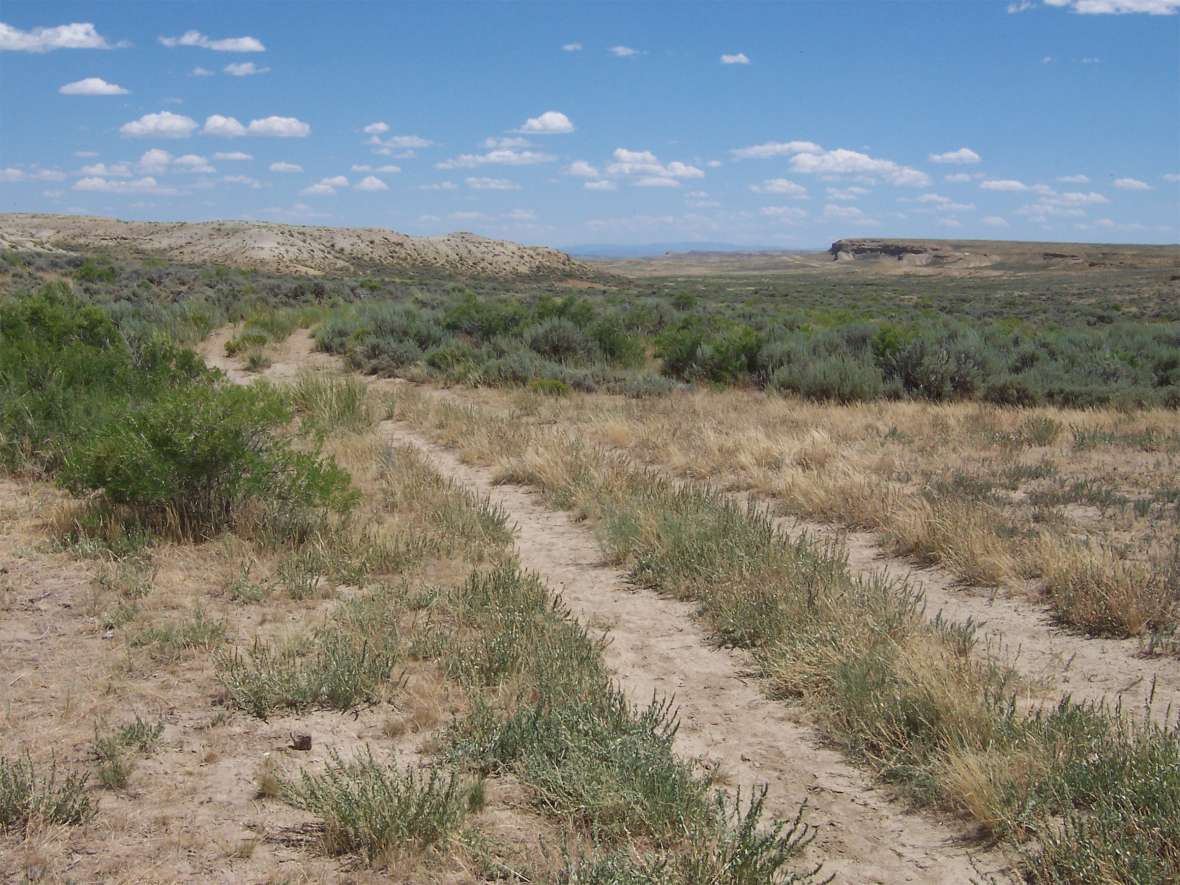
Part of a transcontinental road
The year 1858 saw the beginnings of the Overland Trail as a part of a major transcontinental road system. The development of the Overland Trail was tied to the presence of the U.S. Army at Fort Bridger and in Utah Territory. In 1857, mounting tensions between the federal government and Brigham Young, governor of Utah, led President James Buchanan to appoint a new territorial governor.
U.S. Army troops accompanied the new governor west toward Utah Territory over the Oregon Trail. In October 1857, the army occupied the abandoned Mormon outpost at Fort Bridger which had been burned days before. The destruction of Army supply wagons along the Oregon Trail by Mormon militia halted the Army’s advance at Fort Bridger. The urgent need to provide supplies for 2,500 troops over the winter of 1857-1858 necessitated the development of a military road.
Relief expeditions left Fort Bridger during the winter of 1857-1858 to obtain supplies. One expedition, commanded by Major Isaac Lynde, left Fort Bridger in early December 1857 and followed the Stansbury/Bryan route to Fort Laramie. Major Lynde and Army officers in Washington D.C. were not initially enthusiastic about the trail due to the lack of water, grass and wood.
However, the Army’s attitude changed, helped by Jim Bridger’s endorsement of the route. The Army judged that the advantages in terms of distance and time saved by using Bridger Pass instead of South Pass were substantial and this outweighed the lack of water, grass and wood along the trail. After debating the merits of several routes, the U.S. Army decided in February 1858 that the Lodgepole Creek-to-Bridger Pass route would be developed as a military road.
In late April 1858, elements of the 6th Infantry were ordered to move to Fort Bridger via Lodgepole Creek and Bridger Pass. The infantry assisted Lt. Bryan’s engineers in further improving the road. By July 22 Bryan had completed road improvements to a point 15 miles east of the Green River near modern Rock Springs, Wyo.
Stagecoaches, Emigrants and the Overland Mail: 1859 to 1869
The U.S. Army construction along the Overland Trail was largely complete by the fall of 1858 and both military and civilian traffic began to use the route. In April 1860, the 7th Infantry was reassigned from Utah Territory to New Mexico Territory in response to attacks by the Navajo. The 7th marched east along the Overland Trail. In 1859 and 1860, the Rocky Mountain News in Denver published guides to the Overland Trail for civilians, giving mileages between major camping points and springs.
In 1862 stagecoach magnate Ben Holladay shifted the route of his Central Overland, California and Pikes Peak Express Company from the Oregon Trail to the now well-established Overland Trail. This was due to Indian attacks along the Oregon Trail and to access the business in the booming Colorado Front Range towns. Holladay would use the South Platte River variant—through Virginia Dale—and not the Lodgepole Creek military road.
As the Army had recognized in the 1850s, travel across the Overland Trail would be difficult given the lack of water, grass and fuel. The U.S. Army had begun improving the route between 1856 and 1858 with road construction, improved arroyo crossings and bridges. Water sources such as Barrel Springs were also improved by the Army. Ben Holladay expanded this infrastructure with his stage stations.
Swing and home stations
Holladay built two types of stage stations. Swing stations were built at roughly 10 to 12-mile intervals, but locating a station close to a source of water was a primary concern. Swing stations maintained livestock, horses and company equipment. Water was available from springs, creeks, rivers or wells . Home stations were larger and more elaborate. Spaced 40 to 60 miles apart, they provided meals for passengers and facilities for more extended stopovers. Teams of horses and drivers would be changed at home stations. Telegraph equipment was placed at the home stations when the second transcontinental telegraph line, running along the Overland Trail in addition to the first one along the Oregon Trail, was built in 1862. The stage stations located east of the Continental Divide were largely wood or log buildings while those west of the Divide were constructed of sandstone slabs with wood pole roofs.
Stagecoaches ran year-round. A February 1867 New York Times article described a stagecoach traveling blind through a blizzard. Without knowing it, the stage driver drove up onto the roof of the LaClede Station barn. Although the stage stations were built and maintained specifically for the benefit of the Overland Stage and Mail, emigrants could make use of these services. Dr. Waid Howard wrote of his stop at LaClede on July 31, 1865.
Drove until one o-clock through an awful dust waste and came to the headwaters of the long sought but unknown stream to travelers, known as Bitter creek where we drove our stock four miles to grass and water, whilst McMahan, Doc Bernard and myself went to the ranch [LaClede Station] nearby, sought and obtained a warm breakfast. The lady gave us cream in our coffee, butter and cornbread, pies and molasses three times passing bacon and last but not least, bountiful supply of Black-tail Deer steak, which was most excellent indeed. This however came very near being the cause of our excommunication from our regular mess at camp as our most worthy and accommodating cooks John Vaughne and Jerry Lewis gave us most emphatically to understand they would not by any means permit a repetition of the like again.
The presence of a woman—likely the LaClede Station keeper’s wife—was also mentioned by Ruth Shackleford who passed LaClede on July 28, 1865. She wrote, “we crossed Bitter Creek, a nasty looking stream. The water looks green and is poison.... There is a stone house just this side with three rooms and a porch and a stone wall around the lot I saw one very nice looking lady here”. Shackleford also mentioned the presence of a woman at the Point of Rocks home station. The station keepers were not always as generous to emigrants as was the lady at LaClede. In 1866 the Duck Lake station men tried to force Johann Schmidt to buy water from their well by hiding the bucket. The Salt Wells station men in 1863 also tried to sell well water to emigrants, to the disgust of diarist Howard Cutting.
Bitter Creek was seen as the most difficult section of the Overland Trail. A. K. McClure wrote in 1869, “Bitter Creek, which drains the country, is so impregnated with alkali that neither man nor beast can drink it without injury; and the wells at the stations are almost equally bad. The water if drunk in the usual quantities, produced violent nausea, and does not satisfy thirst. Even in coffee and tea, it is tasted, and the ‘square meals’ seem throughout as if alkali had been spilled profusely on everything”. Howard Cutting wrote, “Bitter Creek is too miserable a stream to have a name. Tho’ I don’t know [how] Emigrants would get across this desert country without it.”
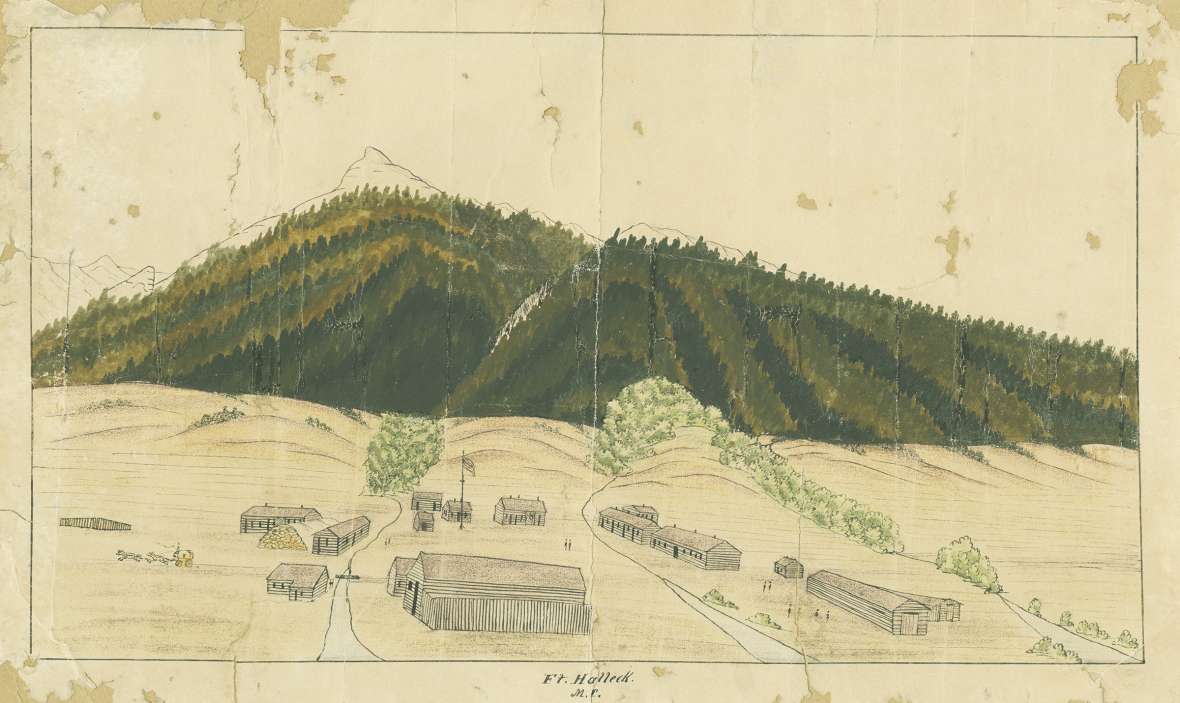
Indian Resistance along the Overland Trail: 1862-1868
The importance of the stage stations to the Overland Trail did not escape the attention of American Indians intent on blocking American expansion into the Intermountain West. The hostilities with the Sioux, Cheyenne and Arapaho which led Holladay to abandon the Oregon Trail eventually spread to the Overland Trail. Fort Halleck was established near Elk Mountain in the fall of 1862 with elements of the 11th Ohio Cavalry stationed there to protect the trail. Troops were posted at the stage stations east from LaClede beginning in 1863.
The year 1865 ushered in a period of Indian raids along the Overland Trail. Between May 26 and June 22, attacks occurred at Bridger Pass, Sage Creek, Pine Grove and Sulphur Springs. On June 2, Washakie Station was attacked, one man was wounded and nine U.S. Cavalry horses were driven off. On the same day, two emigrants were killed in the Sage Creek area, and the country was raided for 50 miles along the mail line. Thirty-one soldiers of the 11th Ohio Cavalry were sent from Fort Halleck to open up the mail route. The Pine Grove and Bridger Pass stations were found deserted; all employees had retreated to the station at Sulphur Springs. At the height of these attacks, the mail was protected by stationing three to five soldiers and a non-commissioned officer at each stage station most likely to be attacked. A mounted escort of cavalry also accompanied the stage at times of greatest peril.
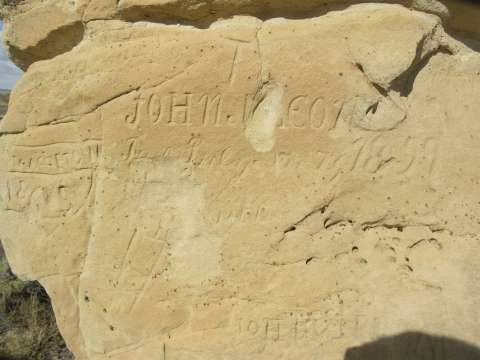
On May 28, 1865, the First Battalion of the Nevada Volunteer Cavalry was sent east from Fort Bridger to patrol the Overland Trail. This contingent set up a temporary headquarters at Washakie Station, and posted five soldiers each at the stations at Rock Spring, Salt Wells, Point of Rocks, Black Buttes and Big Pond. Indian attacks declined in 1866, but the following year fresh hostilities broke out as a result of the Powder River wars to the north. On June 4, 1867, two stage men were killed on Bridger’s Pass, and stock was driven off along the line for a distance of 45 miles east of Sulphur Springs Station. Bridger Pass Station was burned to the ground on June 6 without loss of life. From April 1 to Aug. 15, 1867, the entire Overland Line reportedly lost 350 head of stage stock, 12 stations were burned and three coaches destroyed. Thirteen employees were killed during the attacks. The Peace Commission of 1867 negotiated with the Indians for more than a year and eventually drafted treaties which, by late 1868, largely ended attacks along the Overland Trail in the new Wyoming Territory.
Post-1869 Use of the Overland Trail: 1869-1913
Transcontinental emigrant traffic along the Overland Trail did not end with the completion of the Union Pacific Railroad in 1869. The Overland Trail continued to see emigrant traffic through the 1880s and possibly longer. In 1865, Union Pacific surveyors examined the Overland Trail but ultimately chose a more northerly route across the Red Desert. While the Union Pacific was still building across Nebraska in 1866, Ben Holladay sold his Overland Stage Line to Wells Fargo. Through 1868 Wells Fargo continued running stages west from the nearest station on the Union Pacific railhead. As the railroad was built across what’s now Wyoming in 1868, Overland Trail stage stations closed sequentially from east to west and military posts such as Fort Halleck were replaced by new forts along the railroad. When the Union Pacific and Central Pacific Railroads met at Promontory Point, Utah in May 1869, the era of transcontinental stagecoach traffic through Wyoming ended. Wells Fargo sold its stagecoach holdings in October 1869.
![An inscription reading W.D. C[ompany] A 7th Inf[antr]y, June 21 [18]60 near the Sulphur Springs stage station shows early use of the Overland Trail as a military road. Author photo. Click to enlarge An inscription reading W.D. C[ompany] A 7th Inf[antr]y, June 21 [18]60 near the Sulphur Springs stage station shows early use of the Overland Trail as a military road. Author photo. Click to enlarge](/sites/default/files/styles/medium/public/overland5.jpg?itok=LKfnKPRe)
With the stage stations closed, emigrants created post-1869 Overland Trail variants to bypass the most difficult sections of the trail. One post-1869 route ran north from Sulphur Springs to Rawlins and then continued north through Crooks Gap or Muddy Gap to the Oregon Trail along the Sweetwater River. This variant, used by emigrants since the late-1850s, then followed the Oregon Trail west over South Pass. This was also an active freight road connecting Rawlins with the Sweetwater Mining Districts and the Eastern Shoshone Indian agency at Fort Washakie.
Bypassing Bitter Creek led to the creation of a second post-1869 emigrant variant, the Pine Butte Cutoff. The name Pine Butte Cutoff is modern. The route was used by emigrants in the 1870s and 1880s. The cutoff began at LaClede and ran west, passing Antelope Spring, a source of good water. Wells at cattle and sheep ranches were also used by emigrants. The Pine Butte Cutoff next made the descent of Kinney Rim known to some emigrants as “The Elephant” because it was so steep. After crossing Salt Wells Creek, South Baxter Basin and Aspen Mountain, the western end of the Pine Butte Cutoff met the Union Pacific between Rock Springs and Green River. Emigrants continued west along the Overland Trail to Granger.
Beginning in 1913, the Lincoln Highway became the principal automobile road across southern Wyoming. Portions of the Overland Trail between Point of Rocks and Granger were incorporated into the early Lincoln Highway. Other segments of the Overland Trail saw use in the 20th century as local ranch roads. Some stage stations were reused as sheep ranches but eventually the trail and the stage stations were abandoned to the wind and sand.
Appendix: some Overland Trail sites today
Green River
The Sweetwater County Historical Museum in Green River contains exhibits on the Overland Trail. Green River City was the site of a home station at the point where the Overland Trail crossed the Green River. Overland Park is located near the site of the stage station at the Green River ford. No building remains are present.
Rock Springs
The Overland Trail swing station was named Rock Spring. The town became Rock Springs following the arrival of the Union Pacific. The Rock Springs Historical Museum located in the old city hall contains exhibits on the history of Rock Springs. A historical marker at the site of the Rock Spring swing station is located on Springs Drive north of downtown. No building remains are present. A section of preserved Overland Trail ruts and interpretive signs are located at Stagecoach Elementary School.
Salt Wells stage station
The Salt Wells swing station is located near the point where Salt Wells Creek flows into Bitter Creek. Remains of the building foundation are present. Archaeological excavations at Salt Wells Station in the 1990s revealed that stage stations had flagstone floors and an unexpectedly complex roof structure. The station was torn down for use by the Union Pacific in 1868. Use of metal detectors and unauthorized excavations on public lands are prohibited by law.
Point of Rocks stage station
The Point of Rocks home station is located south of Point of Rocks, Wyo. The station has been restored. Interpretive signs, historic inscriptions and a small cemetery are present. Approximately 1.6 miles east of the Point of Rocks Stage Station on the east side of Bitter Creek are active sulphur springs (not to be confused with the Sulphur Springs home station on Muddy Creek in Carbon County). A large emigrant inscription register is located along the cliffs at these springs. Use of metal detectors and unauthorized excavations on public lands are prohibited by law.
Black Butte stage station
The Black Butte swing station is located along Bitter Creek in the active Black Butte Coal Mine Lease Area. Foundation and wall remnants for the main building and a small outbuilding are located within fenced enclosures. Accessing this site involves driving on mine haul roads. Follow all mine traffic rules. Use of metal detectors and unauthorized excavations on public lands are prohibited by law.
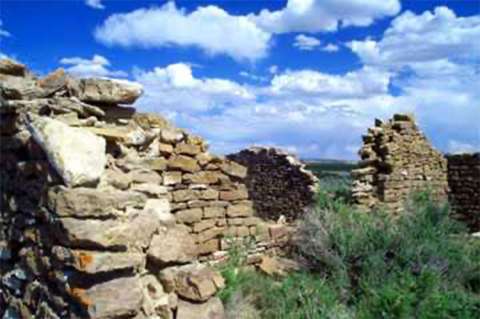
Big Pond stage station
The Big Pond swing station is located along Bitter Creek. Remains of foundations and walls of two buildings are present. Immediately south of the stage station are the remains of an early twentieth century sheep shearing complex. The Big Pond station buildings were reused for sheep ranching following the end of the Overland Trail stagecoach operations. Use of metal detectors and unauthorized excavations on public lands are prohibited by law.
LaClede stage station
The LaClede home station is located near the head of Bitter Creek. The remains of two large buildings are present within a fenced enclosure. For many years in the twentieth century, the LaClede home station was known as Fort LaClede, but this is incorrect. No known nineteenth century document describes LaClede as anything but a stage station and no known nineteenth century document refers to any site as Fort LaClede—as they do for Fort Bridger or Fort Halleck. Also, there are no known U.S. Army records for a military post on the Overland Trail between Fort Bridger and Fort Halleck. Soldiers were deployed intermittently at LaClede and many other stage stations during the 1860s, but this does not make these stations formal military outposts. “Fort LaClede” is now considered to be a twentieth century invention.
Two miles northwest of LaClede is a historic building originally identified as the LaClede stage station. The site is now identified as the early twentieth century Boyer sheep ranch. Use of metal detectors and unauthorized excavations on public lands are prohibited by law.
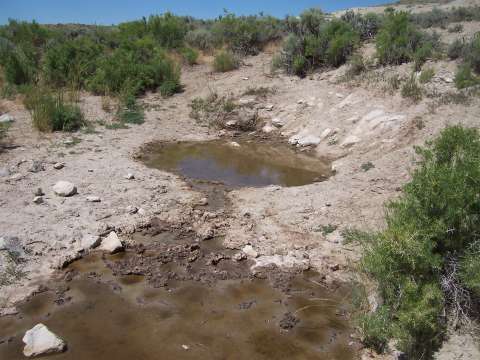
Dug Springs stage station
The Dug Springs swing station is located along a small dry wash. The foundation and lower walls of one building are located within a fenced enclosure, which also contains an interpretive sign. The springs are visible along the east side of the station as two circular areas of wet earth. Several miles of intact Overland Trail ruts run through the site. Use of metal detectors and unauthorized excavations on public lands are prohibited by law.
Duck Lake stage station
The Duck Lake swing station was destroyed by well field construction. No trace of this station remains.
Washakie stage station
A historic marker turnout is located along Highway 789 at the Overland Trail crossing west of Washakie Station. The Washakie swing station is located along Muddy Creek two miles east of State Highway 789 and 20 miles south of the I-80 exit at Creston Junction. The foundation and lower walls of one building are present. Use of metal detectors and unauthorized excavations on public lands are prohibited by law.
Approximately six miles of relatively intact Overland Trail remains run east from the Washakie Station, but at the east end the trail is blocked by locked gates. Locked gates prevent access to the Sulphur Springs home station, which is located on private land.
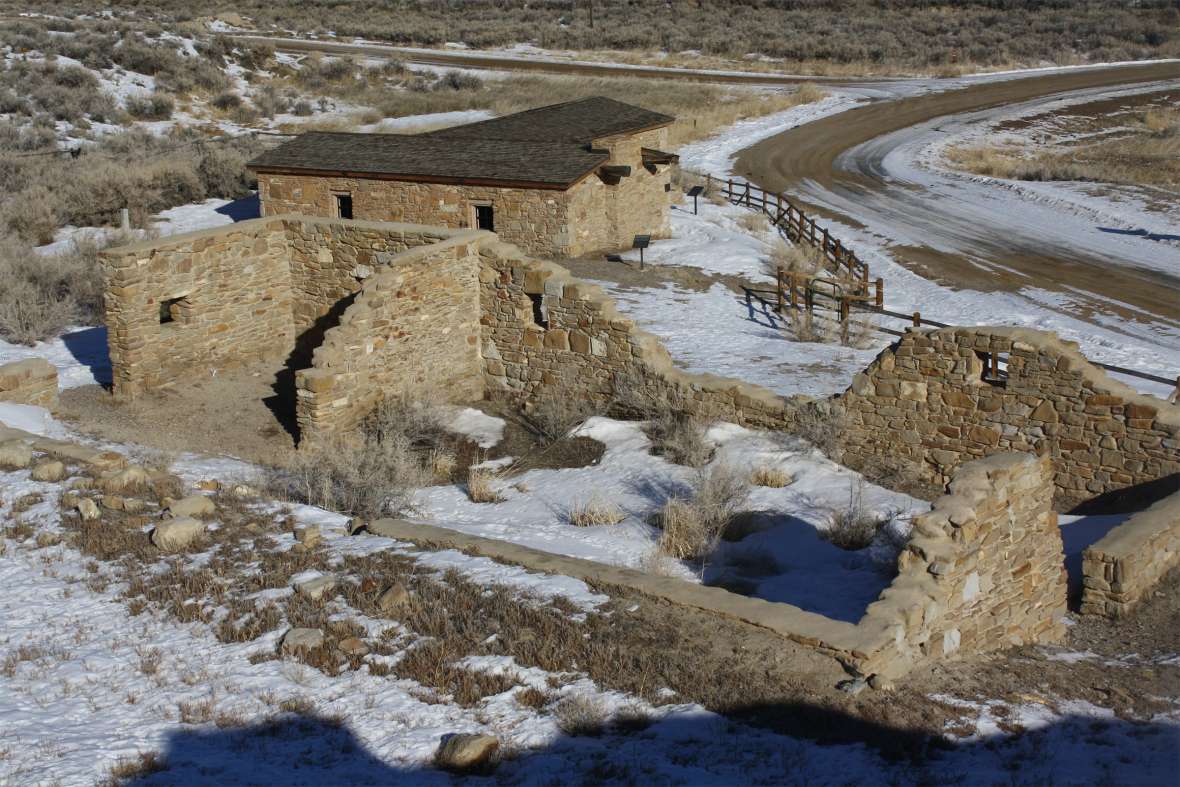
Editors’ note: This article was funded in part by Rocky Mountain Conservancy, a nonprofit Cooperating Association based in Estes Park, Colo., through book store sales at the National Historic Trails Interpretive Center in Casper, Wyo. We offer our special thanks.
Resources
Primary Sources
- Bryan, Francis T. “The Report of Lieut. Francis T. Bryan,” issued as Appendix H to the Report of the Chief of Topographical Engineers, 1856/57. Geological Report by H. Engelmann, 1857, 487-517.
- Cutting, A. Howard. Journal of an Overland Trip, 1863. Manuscript. Henry Huntington Library and Art Gallery, San Marino, Calif., 1863.
- McClure, A. K. Three Thousand Miles Through the Rocky Mountains. Philadelphia: J. B. Lippincott Co., 1869.
- Post Commander, Fort Bridger. Letter to Lt. Stewart, June 22, 1865. Fort Bridger, Letters Sent, 1860-1868. 1865. Wyoming State Archives, Cheyenne, Wyo. (Hereafter WSA)
- Post Returns, 1858-1890. Fort Bridger. Microfilm. WSA.
- Schmidt, Johann H. Johann Heinrich Schmidt Diary. Manuscript. Utah State Historical Society, Salt Lake City, 1866.
- Settle, Raymond W. and Mary L. Settle. Overland Days to Montana in 1865: The Diary of Sarah Raymond and Journal of Dr. Waid Howard. Glendale, Calif.: The Arthur H. Clark Company, 1971.
- Shackleford, Ruth. “To California by the Mormon Trail, 1865.” In Covered Wagon Women: Diaries and Letters from the Western Trails, 1840-1890, Vol. IX, 1864-1868. Edited by Kenneth L. Holmes, 1990, 87-150. Spokane, Wash.: The Arthur H. Clark Co., 1990.
- United States Engineer Department. Stansbury, Howard. Exploration and Survey of the Valley of the Great Salt Lake of Utah. (Published by order of the United States House of Representatives). Washington D.C.: Robert Armstrong, Public Printer, 1853, accessed Oct. 16, 2022 at https://webapps.fhsu.edu/ksherp/bibFiles/63.pdf.
- United States House of Representatives. Executive Documents, The House of Representatives Second Session of the Thirty-Fifth Congress 1858-1859 Vol II, Report of the Secretary of War, Washington D.C. Bartletson, John. “Diary of a Trip from Fort Bridger, Utah Territory, via Bridger’s Pass and Laramie Plain to Fort Laramie, Nebraska Territory.” Washington D.C.: James B Stuman Printer, 1859, accessed Oct. 16, 2022 at https://www.google.com/books/edition/Report_of_the_Secretary_of_War_which_Acc/3L1MAAAAYAAJ?hl=en&gbpv=1&dq=Bartletson,+John.+“Diary+of+a+Trip+from+Fort+Bridger,+Utah+Territory,+via+Bridger’s+Pass+and+Laramie+Plain+to+Fort+Laramie,+Nebraska+Territory.”&pg=PA52&printsec=frontcover.
- _______________________________. Executive Documents, The House of Representatives Second Session of the Thirty-Fifth Congress 1858-1859 Vol II, Report of the Secretary of War, Washington D.C. Bryan, Francis T. Letter to George Andrews, Haystacks, July 19, 1858.
- ______________________________. Executive Documents, The House of Representatives Second Session of the Thirty-Fifth Congress 1858-1859 Vol II, Report of the Secretary of War, Washington D.C. Executive Documents. Washington D.C.: James B Stuman Printer, 1859a.
- ______________________________. Executive Documents, The House of Representatives Second Session of the Thirty-Fifth Congress 1858-1859 Vol II, Report of the Secretary of War, Washington D.C. Loring, W. W. Colonel Loring to Army Headquarters, Camp Scott, Utah Territory, June 11, 1858. Washington D.C.: James B Stuman Printer 1859.
- ______________________________. Executive Documents, The House of Representatives Second Session of the Thirty-Fifth Congress 1858-1859 Vol V, Maps, Washington D.C.: James B Stuman Printer, 1859b.
- United States Postmaster-General. U.S. Postmaster-General’s Annual Report of 40th Congress, 1st Sess., Vol. No. 1327. House Exec. Doc. 1. 1867.
- United States Senate. Testimony as to the Claim of Ben Holladay. 46th Cong., 2nd Sess., Vol. No. 1890, Senate Miscellaneous Doc. 19, Washington D.C.: GPO, 1880, 1-89.
Secondary Sources
- Erb, Louise B., Ann B. Brown, and Gilberta B. Hughes. The Bridger Pass, Overland Trail, 1862-1869. Littleton, Colo., ERBGEM Publishing, 1989.
- Fletcher, Jack E., and Patricia K. A. Fletcher. Cherokee Trail Diaries, Volume 3, 1851-1900. Dexter, Mich.: Thomas-Shore Inc., 2001.
- Gardner, A. Dudley, Debbie Allen and Mike Allen. The Washakie Stage Station and Surrounding Environment, 1849 to 1868. Report prepared by Western Archaeological Services, (Hereafter WAS) Western Wyoming Community College, Rock Springs, Wyo. Also on file at Bureau of Land Management, Rawlins Field Office, Rawlins, Wyo., 1993.
- Gardner, A. Dudley, David E. Johnson, and Russel L. Tanner. The Overland Trail. Report on file at WAS, 1995.
- Gowens, Fred and Eugene Campbell. Fort Bridger: Island in the Wilderness. Provo, Utah: Brigham Young University Press, 1975.
- Hafen, LeRoy R. The Overland Mail, 1849-1869. Cleveland, Ohio: The Arthur H. Clark Company, 1926.
- Jackson, W. Turrentine. Wells Fargo in Colorado Territory. Colorado Historical Society Monograph Series. Denver Colo., 1982.
- Johnson, David E. A Historical Assessment of Overland Trail Segments From the Washakie Stage Station To Sulphur Springs, Carbon County, Wyoming. Report on file at WAS, 2006.
- Johnson, David E., Robert G. Rosenberg, and A. Dudley Gardner. A Historical Assessment of Overland Trail Segments From the Washakie Stage Station To Point of Rocks, Carbon and Sweetwater Counties, Wyoming. Report on file at WAS, 2005.
- Jones, Robert H. Guarding the Overland Trails: The Eleventh Ohio Cavalry in the Civil War. Spokane, Wash.: The Arthur H. Clarke Company, 2005.
- Madsen, Brigham D. Exploring the Great Salt Lake: The Stansbury Expedition of 1849 to 1850. Salt Lake City: University of Utah Press, 1989.
- Rogers, Fred B. Soldiers of the Overland. San Francisco: The Grabhorn Press, 1938.
- Rosenberg, Robert G. and Elizabeth Rosenberg. Wyoming Cultural Properties Form for 48SW1832, Fort LaClede. Wyoming State Historic Preservation Office, Cultural Records Division, Laramie, Wyo., 2003.
- Tanner, Russel L. Who Built the Little Rock Houses: An Ethnoarchaeological Study of the Overland Stage Stations in Southwestern Wyoming. Master of Arts Degree, Plan B Paper. American Studies Department, University of Wyoming, Laramie, Wyo., 1995.
Illustrations
- The Overland Trail map and the photos of the two inscriptions, the trail near Muddy Creek and the wells at Dug Springs are by the author. Used with permission and thanks.
- Bugler Moellman’s sketch of Fort Halleck is from the American Heritage Center at the University of Wyoming. Used with permission and thanks.
- The photos of the trail marker on Highway 789 and the stage station at Point of Rocks are by Tom Rea.
- The photo of ruins at LaClede Station is from Over-land.com. Used with thanks.
